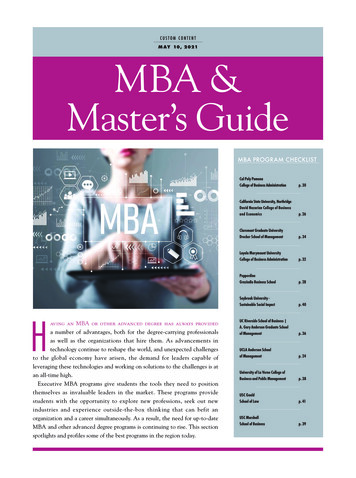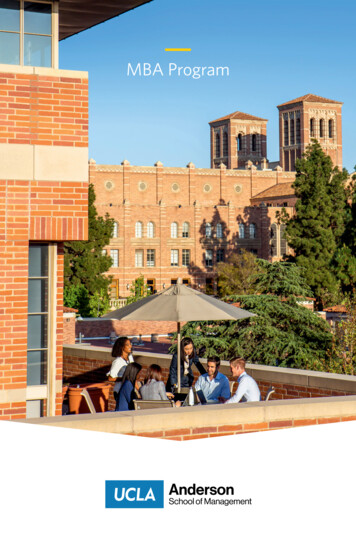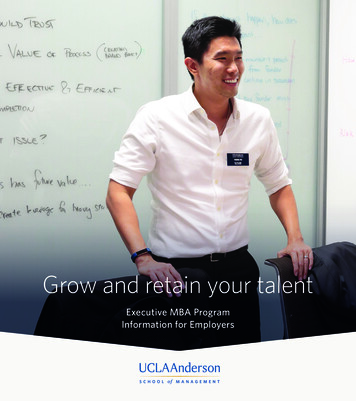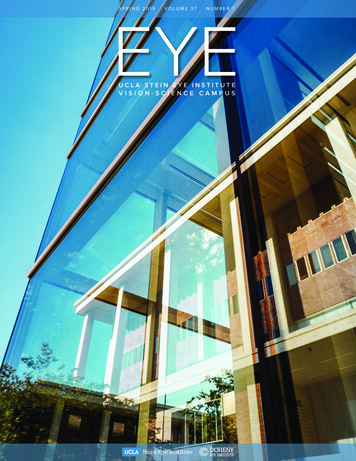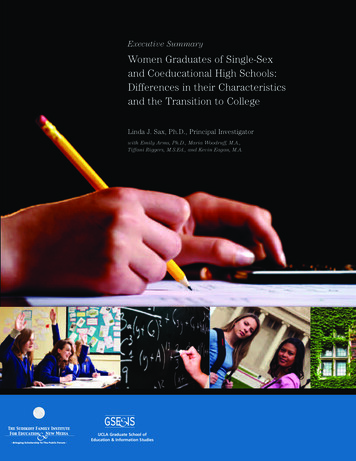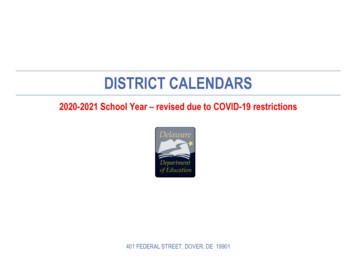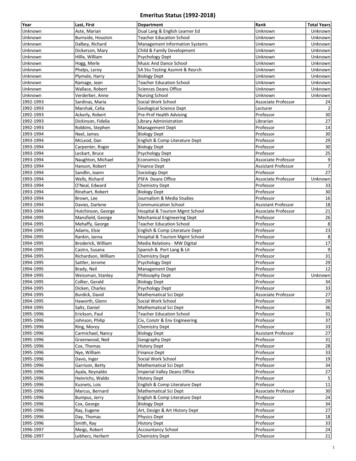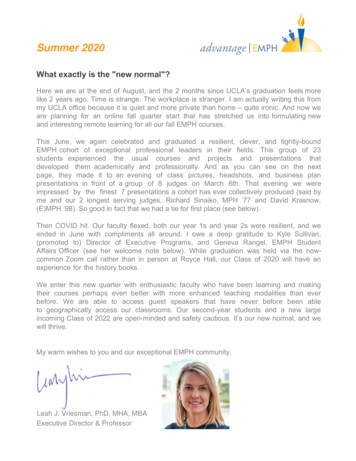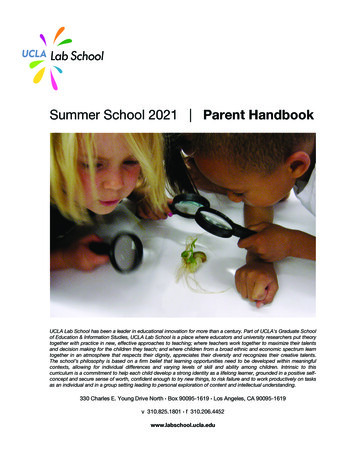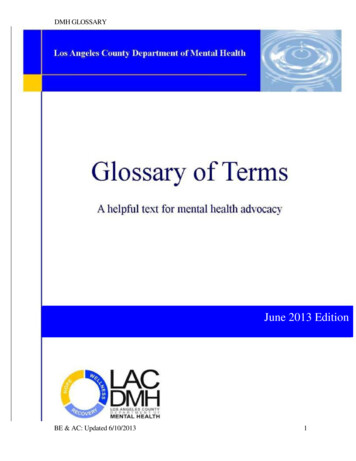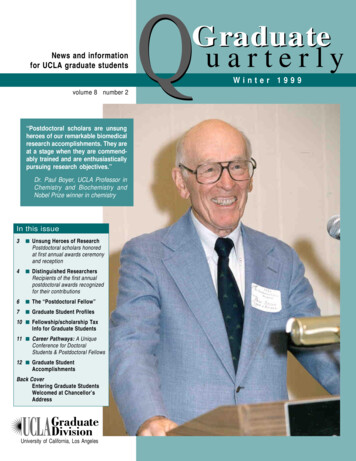
Transcription
News and informationfor UCLA graduate studentsvolume 8 number 2“Postdoctoral scholars are unsungheroes of our remarkable biomedicalresearch accomplishments. They areat a stage when they are commendably trained and are enthusiasticallypursuing research objectives.”Dr. Paul Boyer, UCLA Professor inChemistry and Biochemistry andNobel Prize winner in chemistryIn this issue3 Unsung Heroes of ResearchPostdoctoral scholars honoredat first annual awards ceremonyand reception4 Distinguished ResearchersRecipients of the first annualpostdoctoral awards recognizedfor their contributions6 The “Postdoctoral Fellow”7 Graduate Student Profiles10 Fellowship/scholarship TaxInfo for Graduate Students11 Career Pathways: A UniqueConference for DoctoralStudents & Postdoctoral Fellows12 Graduate StudentAccomplishmentsBack CoverEntering Graduate StudentsWelcomed at Chancellor’sAddressUniversity of California, Los AngelesQGraduateuarterlyWinter 1999
message from the deanDear Graduate Student,Sincerely,Claudia Mitchell-KernanVice Chancellor Academic AffairsDean, Graduate Divisionquote for thoughtAmong all the interactions between faculty members and theiradvanced students, one kind of conflict is particularly pervasive andtroublesome. It involves the very stuff of scholarship itself: data, ideas,experiments, theories. The questions that lie at its heart also lie nearthe heart of scholarly enhancement and prestige: Who thought of it?Who thought of it first? Who did the work? Who should get the credit?In thirteen years as the court of last resort for academic grievanceappeals at a research university, I encountered more difficult, passionately contested complaints in this area than in any other.Donald Kennedy. Academic Duty. Harvard University Press, 1998, p. 98.2Graduate Quarterly, Winter 1999Graduate DivisionDean’s OfficeClaudia Mitchell-KernanVice Chancellor Academic AffairsDean, Graduate DivisionJim Turner, Assistant Vice ChancellorPhillip ChanningThis issue of the Graduate Quarterly departs somewhat fromour usual editorial content in its focus on postdoctoral scholars. I would like to take this opportunity to share with yousome of the reasons why we believe this information would beof interest to many graduate students, and relevant to graduateeducation in general.Each year At UCLA, there are approximately 1,000 registered postdocs on campus. Most are recent doctoral recipientsfrom other universities who stay at UCLA from two to fiveyears working with designated faculty on research projects ofcommon interest. They come from all over the world andmany are international scholars who may have received theirdoctoral degree either in the U.S. or in another country. Postdocs are represented in nearlyall disciplines although the majority are in the laboratory sciences, with the largest numbersinvolved in biomedical research.Our placement data reveals that many recent UCLA PhDs go directly to a postdoctoraltraining position. For example, of the 2,204 PhDs awarded from Winter 1994 to Spring 1997,456 (21%) had accepted a postdoctoral training position within a year of receiving theirdegree. The numbers of UCLA students pursuing postdoctoral training varies widely bydiscipline (e.g., 63% in the academic health sciences; 49% in the physical sciences; 46% in thelife sciences; 7% in public policy and social research; 6% in engineering; 5% in the socialsciences, 3% in the humanities, etc.).Postdoctoral scholars often play an important role in graduate education. They workclosely with graduate students on research projects, assist faculty in training their graduatestudents, and many function as significant mentors and role models for their graduate studentcolleagues.Issues relating to the postdoctoral training position are also an important consideration inevaluating the PhD job market. There is some concern, for example, that time spent inpostdoctoral training status has increased in recent years and that this reflects diminishedemployment opportunities both in academe and the private sector. Surveys of postdocsthemselves, however, suggest that the overwhelming majority are in the position by choice,not because other employment was unavailable. A related concern is that since postdocs arein a rather anomalous category (not faculty, not students, not staff) that they may not receiveappropriate services, benefits and recognition from the universities with which they aretemporarily affiliated. The materials included in this issue of the Graduate Quarterly reflectUCLA’s efforts to begin addressing some of these concerns.Robin Fisher, Associate DeanShirley Hune, Associate DeanGraduate ProgramsKathleen Komar, Associate DeanMatthew Miller, Assistant DeanAcademic Support andInformation ServicesBryant Ng, DirectorGraduate Affirmative AffairsInformation ServicesSpecial FellowshipsComputer ServicesPamela Martin, DirectorGraduate Admissions /Student & Academic AffairsDaniel J. Bennett, DirectorGraduate Student SupportLynn Roych, DirectorGraduate Division Websitehttp://www.gdnet.ucla.eduGraduate QuarterlySusan Young, EditorJacqueline Tasch, Profiles WriterDaniel J. Bennett, News WriterKelly Maglia, DesignThe Graduate Quarterly is publishedFall, Winter and Spring Quarters by theUCLA Graduate Division. We welcomesuggestions and comments, which maybe printed selectively in future issues.Please send correspondence to:Graduate QuarterlyUCLA Graduate Division1252 Murphy HallBox 951419Los Angeles, CA 90095-1419E-mail: syoung@gdnet.ucla.eduPhone: (310) 206-7386 Regents of the University of California
featureContentsUnsung Heroes of ResearchFeaturesUCLA postdoctoral fellows honored at first annual awards ceremonyand receptionUnsung Heroes of ResearchUCLA postdoctoral fellowshonored at first annual awardsceremony and reception . 3Distinguished ResearchersRecipients of the first annualpostdoctoral awards recognizedfor their contributions . 4-5“Postdoctoral scholars are unsungheroes of our remarkable biomedicalresearch accomplishments. They areat a stage when they are commendablytrained and are enthusiastically pursuing research objectives.”Dr. Paul Boyer, UCLA Professor inChemistry & Biochemistry and NobelPrize winner in chemistryThe “Postdoctoral Fellow” . 6Graduate ProfilesPaul Apodaca . 7Michael Frishkopf . 8Laura Martin . 9Graduate InformationScholarship/fellowshipIncome Tax Informationfor Graduate Students . 10BulletinCareer Pathways: A UniqueConference for DoctoralStudents and Postdoc Fellows . 11CSW GraduateStudent Awards . 11Visit the Graduate Division’sNewly Redesigned Website . 11Papers/publications/awardsGraduate StudentAccomplishments 1998-99 . 12-15NewsEntering Students Welcomedat Chancellor’s GraduateStudents Address . back coverCover PhotoDr. Paul Boyer, UCLA Professor inChemistry and Biochemistry andNobel Prize winner in chemistry,addresses postdoctoral fellows andfaculty at the first annual UCLApostdoctoral fellows reception andawards ceremony.Photograph by Todd CheneyASUCLA PhotographyIn recognition of these “unsungheroes,” on November 5, 1998Chancellor Albert Carnesaleand Vice Chancellor and Dean Vice Chancellor and Dean Claudia Mitchell-Kernan (far right)Claudia Mitchell-Kernan hosted the converses with postdoctoral fellows at the reception in their honor.first annual reception and awardsceremony for UCLA postdoctoral fellows.vital role of postdoctoral fellows in UCLA’sThe event, held in the California Room ofmissions of teaching, research and publicthe Faculty Center, included the conferralservice and the need to make sure theirof the newly-established Chancellor’s Awardaccomplishments are recognized by the broadfor Postdoctoral Research to five distincampus community.guished recipients. In addition to Vice ChanVice Chancellor Mitchell-Kernan said thecellor Mitchell-Kernan, other eventreception and awards ceremony is “a camco-sponsors were Brian Copenhaver, Propus-wide expression of appreciation to avost of the College of Letters and Science,group of colleagues who often toil beyondWyatt Hume, Executive Vice Chancellor,the immediate field of vision of the broaderGerald Levey, Provost of Medical Sciencescommunity but whose work continues to beand Dean of the School of Medicine, C.instrumental in maintaining UCLA’s statureKumar Patel, Vice Chancellor for Researchas a premier research university.”Programs and A.R. Frank Wazzan, Dean,Following remarks by several of the otherSchool of Engineering and Applied Scievent co-sponsors, including Executive Viceence.Chancellor Hume, who noted that he firstThe 1998 award recipients honored atcame to UCLA as a ‘postdoc,’ Chancellorthe ceremony were Shannon Daley, PsyCarnesale introduced Dr. Paul Boyer, Prochology; Beth Dreyfuss, Chemistry and Biofessor in the Department of Chemistry andchemistry; Lian Li, Chemical Engineering;Biochemistry and winner of the Nobel PrizeFrançisco Raymo, Chemistry and Biochemin chemistry. Dr. Boyer contributed 75,000istry; and Zhi-Ming Shao, Pathology andof his Nobel Prize money to UCLA, to enLaboratory Medicine.dow a Postdoctoral Recognition Fund toEach of the Chancellor’s awards is acannually recognize excellence in research incompanied by a 3,000 cash prize. A selecbiochemistry and/or molecular biology. Intion committee composed of faculty andaddition, other portions of the prize moneyacademic administrators reviewed the qualiwere donated to the Universities of Wisconfications of 30 candidates nominated bysin and Minnesota. Dr. Boyer hopes thesefaculty. The committee evaluated such facawards “will stimulate other ways of providtors as creativity, productivity and impacting professional and financial recognition foron the field of research.our postdoctoral scholars.”In his remarks, Chancellor CarnesaleFollowing the conferral of awards, parindicated his pleasure and pride in bringingticipants and guests enjoyed refreshments,together postdoctoral fellows, faculty menand entertainment provided by the UCLAtors and administrative leaders of the acaString Quartet.demic programs “to honor the importantBy Daniel J. Bennettachievements and contributions of UCLA’sPhoto by Todd Cheney, ASUCLA Photography‘postdocs.’” The Chancellor emphasized theGraduate Quarterly, Winter 19993
featureDistinguished ScholarsRecipients of the first annual Chancellor’s Award for PostdoctoralResearch recognized for their contributionsShannon E. DaleyPsychologyShannon Daley has been involved in anongoing in-depth study of 155 women, following them from age 18 into young adulthood to see how depression and otherpsychopathology interacts with stress in theirlives. Introduced to this research as a UCLAgraduate student in psychology, she has hada substantial impact on its direction as apostdoctoral fellow. Dr. Daley has “established herself as someone so capable andclear-thinking about complex issues that Ioften call upon her ideas to help me resolvetheoretical or statistical questions,” says hersponsor, Dr. Constance Hammen.It was Dr. Daley who decided to look notonly at depression but also at personalitydisorders, which are permanent features ofthe personality that may cause difficulties inrelationships. An example is called borderline disorder. People with this personalitytype experience intense and rapid moodswings, leaving friends and family struggling to react appropriately.Dr. Daley found that there was a strongrelationship between personality disorders,depression, and life stressors. For example,young women who demonstrated these psychological problems at age 18 had a 40%chance of reporting an abusive relationshipover the next few years. They also experienced an inordinate number of unwantedpregnancies.Although Dr. Daley’s work does not involve clinical treatment, her findings mayinspire others to look at providing treatmentfor depression and personality disordersearly in adolescence. Most women are 15 to19 years old when they first report seriousdepressive symptoms.Dr. Hammen also remarked on Dr.Daley’s mentoring of graduate students. “Itis clear that the junior students greatly admire and appreciate her level of professionalism and approachability.” To Dr. Daley,all this is just returning an old favor. “WhenI was a graduate student, there was a postdocon the project who really helped me with thenitty-gritty, nuts and bolts stuff you don’twant to bother your adviser about,” Dr.Daley says. “I think the postdoc provides anice bridge there.”4Graduate Quarterly, Winter 1999Dr. Daley urges graduate students tofind a subject that they are really interestedin, to motivate them through the detail workthat is involved in most research. She alsorecommends being strategic. “Most postdoctoral fellowships last for a few years atmost,” she says. “You need to think aboutwhat you can get out of it in that time.”One of the offbeat accomplishments ofher postdoctoral years is that she and herhusband learned swing dancing. ”You haveto have a life,” she says. “If you don’t replenish yourself, you won’t be productive.”Enjoying both research and teaching,Dr. Daley is now looking for an academicposition.Beth Welty DreyfussChemistry and BiochemistryBeth Dreyfuss has been looking at how cellsmake protein, particularly the final process,when cells bring proteins and co-factorstogether for synthesis. The proteins thatinterest her are involved in breaking downfoods and in photosynthesis, using and creating energy. Although she’s studying plants,the proteins are common in other life forms,and so her research could have wider implications. “Once you understand a generalcellular process, you can often make a lot ofimplications about how it might be going onin another organism” she says.Always interested in plant biology, Dr.Dreyfuss was drawn to UCLA for her PhDwork by a group of researchers which had agrant to study plant molecular biology. Although she stayed at UCLA as a postdoctoralfellow, she is well-traveled, attending international and regional meetings in her subject area. “Once you know people –personally have met them – it’s certainly alot easier to establish a collaboration or justto pick their brains. It makes the scientificcommunity smaller, once you get out thereand meet people.”Among her travels was a three-monthstay in Geneva with Jean-David Rochaix, aleading researcher and pioneer in the fieldof plant molecular biology. She returned toUCLA with a repertoire of new techniquesfor Sabeeha Merchant’s laboratory. “Thanksto her, they are now not only routine butthey are rather an indispensable tool formany of the projects in the group,” Dr.Merchant says.The group includes graduate students.Although there are elements of mentoringinvolved, Dr. Dreyfuss sees graduate students mostly as coworkers. “You’re sort ofin between the principal investigator or theprofessor and the graduate students,” shesays. “You’re peers with both sets.”The negative part of being a postdoctoralfellow is the “finite amount of time” youhave to produce results, Dr. Dreyfuss says.On the other hand, you have the “wonderfulluxury” of being able to focus completely onresearch, without the distractions of teaching or taking classes, handling administrative duties, and writing grant proposals.Still, Dr. Dreyfuss wants to teach: “Shehas the ability to present concepts clearly,”Dr. Merchant says, “and she is patient withstudents in the classroom and in the laboratory environment.” Dr. Dreyfuss is interested in teaching at an undergraduateinstitution like her alma mater, Kenyon College.An experienced ocean swimmer, Dr.Dreyfuss used to swim regularly. Althoughshe swam through her pregnancy, her child’sinfancy, and now toddlerhood, have kepther somewhat land-bound.Lian LiChemical EngineeringLian Li is working on research that mayeventually advance the fabrication technologies for materials called compound semiconductors, which are used to make a rangeof indispensable items, from cell phone transistors to traffic lights.Using a method called metalorganicchemical vapor deposition (MOCVD), Dr.Li and others working in the laboratory ofRobert F. Hicks are learning how to improve and make new materials out of two ormore elements from group III (Al, Ga, andIn) and group V (N, P, and As). Such materials might make cellular phones work longerand weigh less. A traffic light using a compound of gallium nitrides could glow for 100years, instead of a few thousand hours. Inaddition to saving maintenance costs, thisnew technology could also save energy.After receiving his PhD in physics fromArizona State University, Dr. Li was apostdoctoral fellow at Tohoku University inSendai, Japan, when he saw an advertisement that Dr. Hicks had placed in a journal.Besides finding the projects interesting, Dr.
featureRecipients of the first annual Chancellor’s Award for Postdoctoral Research: (left to right) Zhi-Ming Shao,Lian Li, Shannon Daley, Beth Dreyfuss, and Françisco Raymo.Li thought he was just the right person to meetDr. Hicks’s needs.First of all, Dr. Hicks was looking forsomeone to provide his laboratory with acapability for in situ scanning tunneling microscopy of materials grown by MOCVD.Within several months of his arrival in 1996,Dr. Li “was generating beautiful images of theatomic features on GaAs(001) surfaces,” saysDr. Hicks, adding that his group is so far theonly one in the country to achieve successwith this project.Dr. Hicks was also looking for someone toprovide leadership to the graduate studentsworking in his laboratory. Dr. Li’s “manyideas and exceptional achievements havedrawn my graduate students into collaborating with him,” Dr. Hicks says. “These students are learning a great deal from Lian. . . .As a result of his mentoring, the students’productivity has exceeded my expectations,and I am enjoying all the scientific discoveries that the group is making.”From Dr. Li’s point of view, his relationship with Dr. Hicks has been among thepositive elements of being at UCLA. “I havea lot of freedom to do research,” he says. “Ican tell him I have this idea in my mind andI want to develop this project. Most of thetime, he’s supportive.”Dr. Li also enjoys helping students “develop research projects and review theirprogress,” offering them the benefit of hisexperieince and the knowledge base he hasacquired. “We enjoy working together,” hesays, “and I benefit too because my professional goal is to become a professor. Closelysupervising students is an important part ofthe job. I am enjoying doing that.”Françisco RaymoChemistry and BiochemistryFrançisco Raymo has influenced the futurecourse of chemistry while still in his twenties– and while working as a postdoctoral fellowat UCLA – making profound contributionsin both experimental and theoretical understanding of the nature of the mechanicalbond.At the end of 1996, Dr. Raymo spent amonth working with K. N. Houk, a worldleader in computation chemistry. A particular class of interlocked molecules (calledrotaxanes) are made up of a macrocycliccomponent encircling a dumbbell-shapedcomponent. Using computational methods,Dr. Raymo modeled how these moleculesare assembled and disassembled. Besidesthe theoretical contributions to research ofhis finding, his approach is likely to becomea teaching exercise for courses in computational chemistry. Later, he developed computational strategies for understanding othermechanically interlocked molecules (calledcatenanes), in which macrocyclic components are linked to each other.In 1997, he returned to UCLA as part ofthe research cohort accompanying J. FraserStoddart, formerly of the University of Birmingham in the UK. Working with Dr.Stoddart but in frequent collaboration withDr. Houk, Dr. Raymo is continuing hisstudy of the structural and electronic properties of catenanes and rotaxanes. He isinterested in two topics involving these molecules in modern chemical science: Is itpossible to construct molecule-size chainsof mechanically linked components? Is itpossible to design and construct moleculesize machines that can be controlled fromthe outside? Dr. Raymo’s experiments haveprovided a positive answer to the first question, and he is making progress on accomplishing the second. “These discoverieswill have a tremendous impact on the technology of the next century,” says Dr.Stoddart. “I can only speculate that if hemaintains and sustains the present qualityand quantity of his scientific output in theyears to come, then in 20 years (or evenless), colleagues will be nominating him forthe Nobel Prize in Chemistry.”Dr. Raymo has already made his markon the international chemistry scene. Hisextraordinary performance as a PhD student at the University of Birmingham ledto his selection by the European Commission as a Marie Curie Fellowship SuccessStory. He and his work are well-known toleading chemical scientists around the world.He has 62 publications, many of them inhigh-profile journals.Delighted with his experience at UCLA,Dr. Raymo has no immediate plans to leave.“For numerous reasons, UCLA is the bestacademic institution among those where Ihave worked so far,” he says. Dr. Raymoalso remarks on the opportunities “to workwith several very talented graduate students. Most of the results I have achieved atUCLA arise from fruitful and stimulatingcollaborations with these students.”Zhi-Ming ShaoPathology and Laboratory MedicineZhi-Ming Shao became interested in breastcancer when he was a resident in surgicaloncology at Shanghai Medical University’sCancer Hospital. Among the journal articles he read were some that reported workin the pathology laboratory of Sanford H.Barsky at the UCLA School of Medicine.Dr. Shao contacted Dr. Barsky, and theircontacts resulted in a postdoctoral fellowship for Dr. Shao, which began in 1997.The researchers in Dr. Barsky’s laboratory are interested in breast cancer metastasis: how the cancerous cells spread throughthe body. Dr. Shao helped to advance thelaboratory’s work in research on the myoepithelial cell. When cancer begins, a layerof myoepithelial cells lies between cancerous cells and normal cells. This layer isbreached as breast cancer progresses. Whenresearchers know how that happens, theymay be able to prevent it.Continued on next pageGraduate Quarterly, Winter 19995
featurePostdoctoral AwardsThe “Postdoctoral Fellow”Continued from page 5Dr. Shao also came to UCLA with aresearch interest of his own. It has oftenbeen observed that Asian women experience much less breast cancer (anddeath from breast cancer) than womenin the United States and other Westerncountries. Because Asian women alsoeat more soy products – Chinese womeneat 20 to 50 times as much soy asAmerican women – a connection hasbeen hypothesized. Dr. Shao decidedto examine this relationship.He found that genistein, a naturalphytoestrogen found in soy, tends tosuppress breast cancer, both in laboratory experiments and in women, andhe has begun to describe the multipleways in which this happens. His workwas published in the November 1998issue of Cancer Research, a journal thathas considerable influence in the field.For now, Dr. Shao’s work will have asignificant effect on drug treatmentsdesigned to prevent breast cancer. Inthe future, he hopes his research willhelp to treat women who have alreadybeen diagnosed.“It is unusual for a mentor to encourage you to work on your own project,”Dr. Shao said, “but Dr. Barsky did.”Perhaps because of this model, Dr. Shaohas gone out of his way to be helpful toother researchers in the laboratory, hismentor says. “Dr. Shao has workedunselfishly in assisting my other graduate and postdoctoral students in theirresearch efforts,” Dr. Barsky says, “evenassisting other graduate students on papers he was not directly involved in asa coauthor.”The collegial relationships are partof what Dr. Shao describes as a “verygood research environment” at UCLA.His work on genistein was a majorcollaborative effort between the Shanghai Medical University and UCLA and“will lay the groundwork for futurecollaborative studies between our respective institutions,” Dr. Barsky says.Dr. Shao is married to Qiao-Ling Li,a medical doctor who is conductingresearch in the microbiology of thyroiddisease at the Cedars-Sinai MedicalCenter.The majority of postdoctoral fellows (“postdocs”), both at UCLA and at othermajor research universities in the United States, are science and engineering doctoral recipientswho perform research and receive additional training under the mentoring of a senior facultyinvestigator. Some postdocs are paid from training grants and individual traineeships while themajority are funded from faculty research grants. In many biomedical and other fields, a periodof postdoctoral training (also called a “postdoc”) is all but required in order to secure a tenuretrack faculty position.In the humanities and social sciences,the term “postdoctoral fellow” often dePostdocs at UCLA by Academic Areascribes a different academic experience.Humanities1%For nonscientists, a postdoctoral fellowship, such as those offered by the MellonSocial SciencesEngineering3%11%or the Woodrow Wilson Foundations orPhysical SciencesUCLA’s Institute of American Cultures,15%provides recent doctoral recipients withthe opportunity to pursue independentresearch while receiving stipend support and remaining closely affiliated withLife Sciencesa host department or institution’s com13%munity of scholars.For More Information on PostdocAppointments·postdoctoralFor more information aboutfellows at UCLA, visit theGraduate Divisionwww.gdnet.ucla.eduatSource: UCLA Graduate Division postdoctoral database for 1997-98.·recipients:The UC Office of the President offers the President’s Postdoctoral Fellowship to UC doctoralwww.ucop.edu/acadadv/fgsaa/f-conts.html· The Graduate and Postdoctoral Extramural Support (GRAPES) database,maintained by theGraduate Division, featuresPercentageof PostdocsPercentage of UCLA DoctoralRecipientsPursuing Postdoc merous opportunities forpostdoctoral fellowships ina variety of ocialSciencesHealthSciencesEngineeringSource: UCLA Graduate Division Doctoral Placement Study (1994-1997).Science’s Next Wave, anonline service of the American Association for the Advancement of Science(AAAS), has listings of positions and a wealth of upto-date information aboutgraduate and postdoctoraltraining in the sciences:www.nextwave.org·researchThe Association of American Universities, an organization representing America’s majoruniversities, has published a report on the status of postdoctoral training in the UnitedStates. It provides specific recommendations for improving postdoctoral training, many of whichare already in place at UCLA: www.tulane.edu/ aau/PostdocEducationReport.htmlProfiles by Jacqueline TaschPhoto by Todd CheneyASUCLA Photography6websiteHealth Sciences57%Graduate Quarterly, Winter 1999By Matthew Miller
student profilesPaul ApodacaFolklore and MythologyPaul Apodaca was a young boy when he was firstintroduced to the Cahuilla Indians of SouthernCalifornia. His father, a Navajo Indian, often tookPaul on long rides into the deserts east and south oftheir Orange County home, giving his son numerous opportunities to meet the people who were partof his cultural ancestry.In January, Paul filed his dissertation on the BirdSongs of the Cahuilla Indians. Although they arecalled Bird Songs, they are not songs about birds or songs thatimitate bird vocalizations. The name comes from Cahuilla mythology. According to their migration myth, the Cahuilla traveled threetimes around the world before settling into their homelands in whatis now Palm Springs and the neighboring areas. As they traveled,they took note of the birds they saw and heard. Thus, the journeyswere recorded in three Bird Song cycles, or groups of songs. Two ofthese cycles have been lost to time but Paul has had a large part inassuring that the last cycle will never disappear.“UCLA has given me all of the academic resources to make thestory of the Cahuilla Bird Songs something that would be importantand credible for everybody,” Paul says. His master’s and doctoralwork also provided “the final skills I have needed to be able tocontinue on this interesting path that the gods created for me fromthe time I was small.”As Paul suggests, a colorful thread, now more than four decadeslong, connects his childhood experience with the most recent of hismany achievements. The journey began in the mid 1950s, when theApodaca family moved from Los Angeles to Orange County. Hisfather made a habit of seeing that his son got to know “the people andplaces that were important to our collective histories,” Paul says.As he moved among the various historical cultural communitiesin Southern California, he kept running into academic researcherstracking the same information he was seeking. Often drafted as anintermediary between the academics and the native people, Paulbegan to absorb the academic viewpoint, learn the professionalvocabulary, and become familiar with the literature academics read.Eventually, the academics saw that Paul could “actually articulatethese things in ways that are both culturally accurate and academically credible.”He began getting invitations to lecture or make presentations atvarious cultural institutions in Southern California: the SouthwestMuseum, the Los Angeles Natural History Museum, the BowersMuseum–and UCLA, where he spoke to classes in the AmericanIndian Studies program. The Smithsonian Institution brought himto Washington to learn techniques of musicological research. TheCalifornia Arts Council funded his designation as an artist inresidence at the Bowers.In 1980 the Bowers Museum offered Paul full-time employment,and he accepted. “I thoug
3 Unsung Heroes of Research Postdoctoral scholars honored at first annual awards ceremony and reception 4 Distinguished Researchers Recipients of the first annual postdoctoral awards recognized for their contributions 6 The "Postdoctoral Fellow" 7 Graduate Student Profiles 10 Fellowship/scholarship Tax Info for Graduate Students
